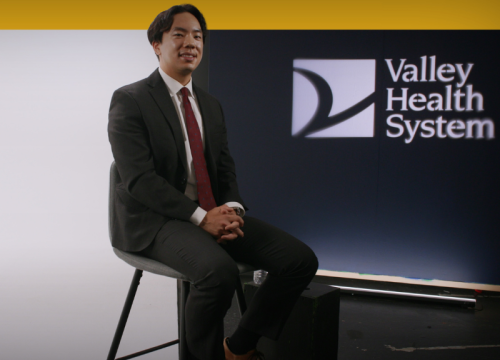Brain angiograms (cerebral angiograms or arteriograms) are minimally invasive procedures to examine blood vessels in or near your brain.
Angiograms use X-rays to diagnose and monitor many different brain conditions, including:
- Bulging of a blood vessel in your brain (aneurysm)
- Inflamed blood vessel in your head (vasculitis)
- Narrowed blood vessel in your head or neck (stenosis)
- Narrowed artery in your head or neck (atherosclerosis)
- Abnormal connections in your blood vessels (arteriovenous malformations)
- Increased pressure inside your skull (idiopathic intracranial hypertension)
- Hearing your own heart-beat or heart beat related whooshing noises (pulsatile tinnitus)
- Blood clots, stroke or blockages in your blood vessel
- Blood vessel spasms in your brain (vasospasms)
- Brain tumors
Valley’s endovascular neurosurgeons are highly skilled at performing angiograms so you have less pain and a faster recovery. They’ll also provide a diagnosis so you can receive treatment you need when you need it.
Am I a Candidate for a Brain Angiogram?
Your endovascular neurosurgeon may suggest a brain angiogram if a regular brain scan shows an abnormality on your blood vessels in the brain, or you have symptoms such as:
- Whooshing sound in your ears (pulsatile tinnitus)
- Headaches
- Vision changes or vision loss
- Dizziness
- Fatigue
- Vomiting and nausea
- Neck, shoulder or back pain
- Difficulty walking
These symptoms could be signs of a serious condition, so getting the right diagnosis quickly is important. At Valley, our team has extensive experience performing brain angiograms to identify and monitor all types of brain conditions.
Benefits of a Brain Angiogram
Unlike other imaging tests of the brain, surgeons can perform angiograms at the same time they treat your problem. That’s because angiograms involve catheters (tubes) inserted into blood vessels. Many minimally invasive treatments for brain conditions also use catheters.
For example, if you have an aneurysm, your neurosurgeon can perform an angiogram as a “roadmap” before brain surgery. This helps them identify the precise location of the aneurysm and determine how they will treat it. Or if you have a narrowed artery or vein in the head or neck, an angiogram shows your neurosurgeon where to place a tube (stent) to open it.
Benefits of Angiograms Through the Wrist
Valley’s endovascular neurosurgeons perform most angiograms through a tiny hole in the wrist — not the groin. Only specially trained endovascular neurosurgeons can perform brain angiograms through the wrist (radial artery access).
Compared with angiograms through the groin, angiograms through the wrist have many benefits, including:
- Less pain and bleeding
- Fewer complications like infection
- Faster recovery (only 90 minutes lying down after wrist access compared to four to six hours with groin access)
What to Expect: Brain Angiogram
Our goal is to make sure you know exactly what to expect at every step of your brain angiogram. That’s why your Valley endovascular neurosurgeon will give you the information and support you need. Our team will answer all your questions about your cerebral angiogram, so you feel confident and prepared.
Before Your Brain Angiogram
Here’s what you can expect before your cerebral angiogram:
- Tell your care team about all medicines you take, including over-the-counter medicines, herbs and supplements. If you take blood thinners, you may need to stop taking them before your angiogram. But do not stop any medicines unless they tell you to do so.
- Tell your team if you are allergic to medicines, contrast dye, iodine or shellfish.
- Tell your doctor if you are pregnant or think you might be pregnant.
- Do not eat or drink anything for 8 hours before the procedure unless your doctor gives you other instructions.
- Ask someone to drive you to the hospital on the day of your angiogram. You’ll need someone to drive you home after the procedure.
During Your Brain Angiogram
Here’s what you can expect during your cerebral angiogram:
- Your nurse will start an intravenous (IV) line with medication to help you relax.
- Your team will include your neurosurgeon, nurse, technologists and may also include an anesthesiologist. They will perform your angiogram using computer guidance systems and 3D imaging for brain vessels.
- You will lie down on an X-ray table while we monitor your breathing, heart rate and blood pressure.
- Your team will give you an injection to numb the insertion site on your wrist. Then, your neurosurgeon will thread a thin tube (catheter) through your wrist to an artery in your neck using ultrasound guidance. They will inject a special dye so they can see your blood vessels on a specialized X-ray, called fluoroscopy.
- Your team will take several videos of the blood flow of the vessels in your head or neck. They’ll remove the catheter and put a wrist band on your insertion site to stop the bleeding.
- A brain angiogram usually takes 45 minutes, although your procedure may be shorter or longer.
Recovery After Your Brain Angiogram
Here’s what you can expect after your cerebral angiogram:
- You’ll go to the recovery room and our nurses will monitor you. They will give you pain medicine if you are uncomfortable.
- If your neurosurgeon used a blood vessel in your wrist, you’ll have a small, compression wristband. You’ll wear this wristband for an hour to minimize any bleeding. You can go home about 90 minutes after your angiogram.
- Through rare, we do sometimes need to do groin access. If your neurosurgeon used a blood vessel in your groin, you’ll need to rest in bed for four to six hours before you can go home.
- Your neurosurgeon will discuss the early findings from your angiogram before you go home. If we find a problem like an aneurysm that requires immediate treatment, we may perform another procedure after your angiogram. If that happens, you may need to stay in the hospital overnight or longer.
- You should avoid strenuous activities for 48 hours after your angiogram.
- You may have a small bruise and some soreness on your wrist or groin.
- In a week or so, you’ll return to your neurosurgeon’s office to discuss your results in more detail. You’ll also talk about next steps for your treatment, based on your goals and preferences.
After your brain angiogram, call your neurosurgeon if you have:
- Numbness in your hand or leg
- Muscle weakness
- Dizziness
- Vision or speech problems
- Redness, itching or swelling on your wrist or groin
- Fever or chills
- Chest pain
Why Choose Valley for Your Brain Angiogram
- Radial artery (wrist) access to the brain: Most surgeons at other hospitals still perform brain angiograms through a groin artery. At Valley, our neurosurgeons are skilled in using an artery in the wrist instead. Wrist access causes less pain and bleeding, compared with angiograms through the groin. You’ll also have a faster recovery.
- Minimally invasive brain surgery expertise, close to home: If your angiogram reveals a problem that requires brain surgery, Valley’s neurosurgeons can usually treat the problem with minimally invasive brain surgery. Our hybrid operating room (OR) has the latest technology, including brain angiograms, for minimally invasive brain surgery. We also have a dedicated neuro ICU, staffed by our nurses who receive additional training on caring for people who have brain surgery.
- Easy, convenient scheduling: Our coordinator will take care of scheduling your brain angiogram, so there’s less hassle for you. They’ll help coordinate your insurance approvals and test results you may need from your other providers.
- In-depth patient education: We want to make sure you feel prepared and confident before your procedure. Once you are scheduled, our nurse educator will send you patient education to help you prepare for your procedure. This information will explain every step of your brain angiogram, so you know what to expect.
- Multiple experts guide your care: Our neuroendovascular team meets every week to review each patient’s case and determine the best treatment. Together, our experienced endovascular neurosurgeons will review your angiogram and recommend care that follows evidence-based standards.
















